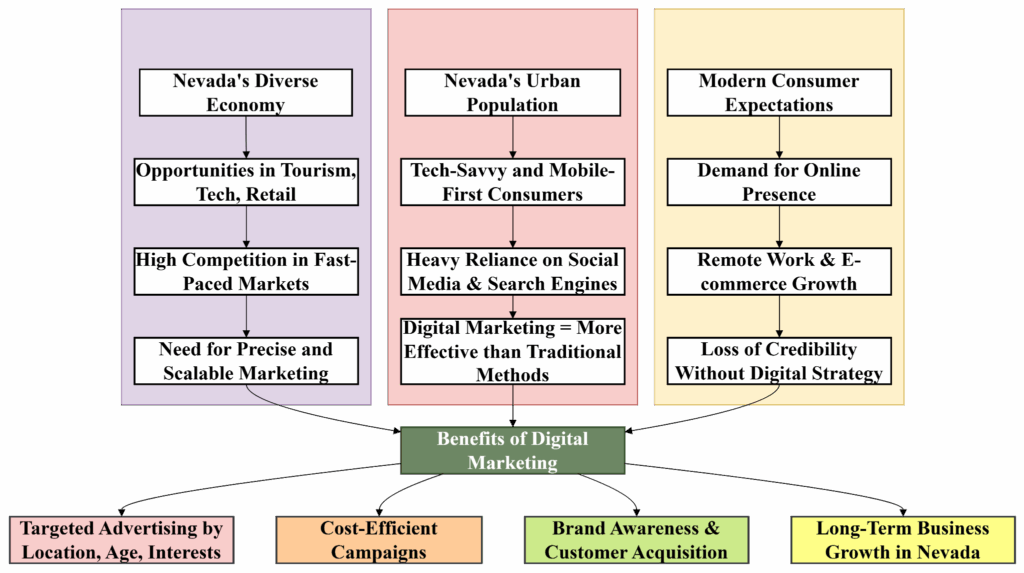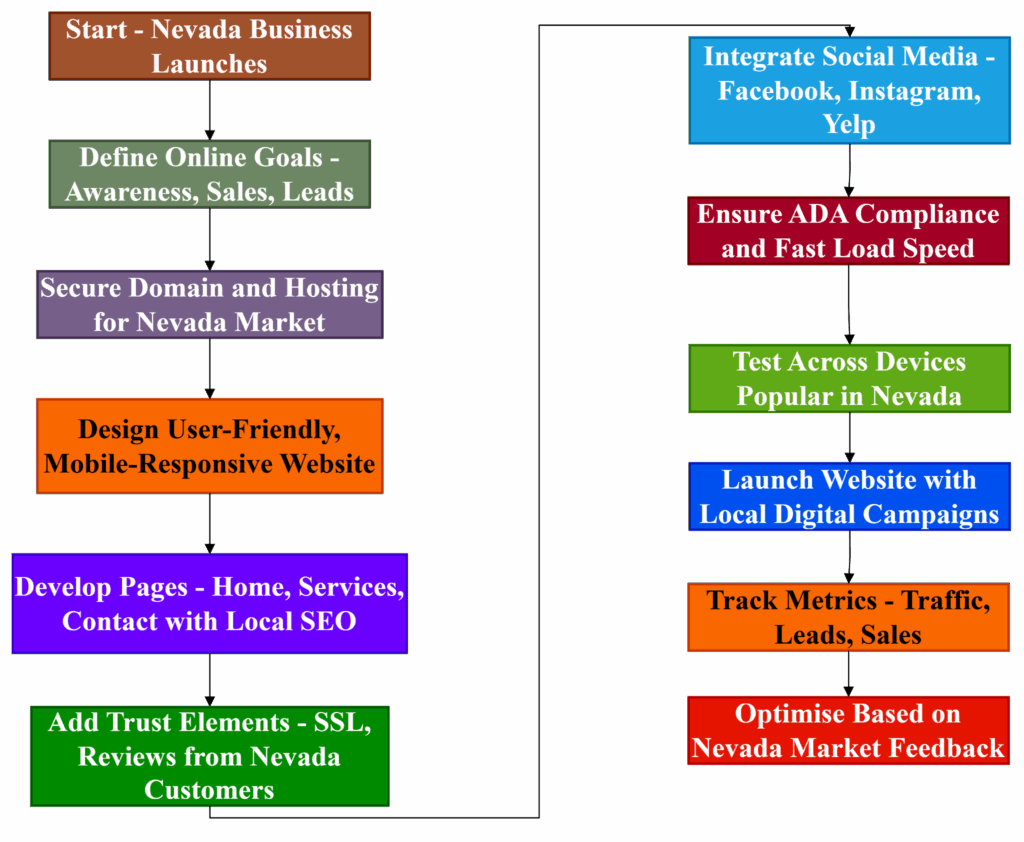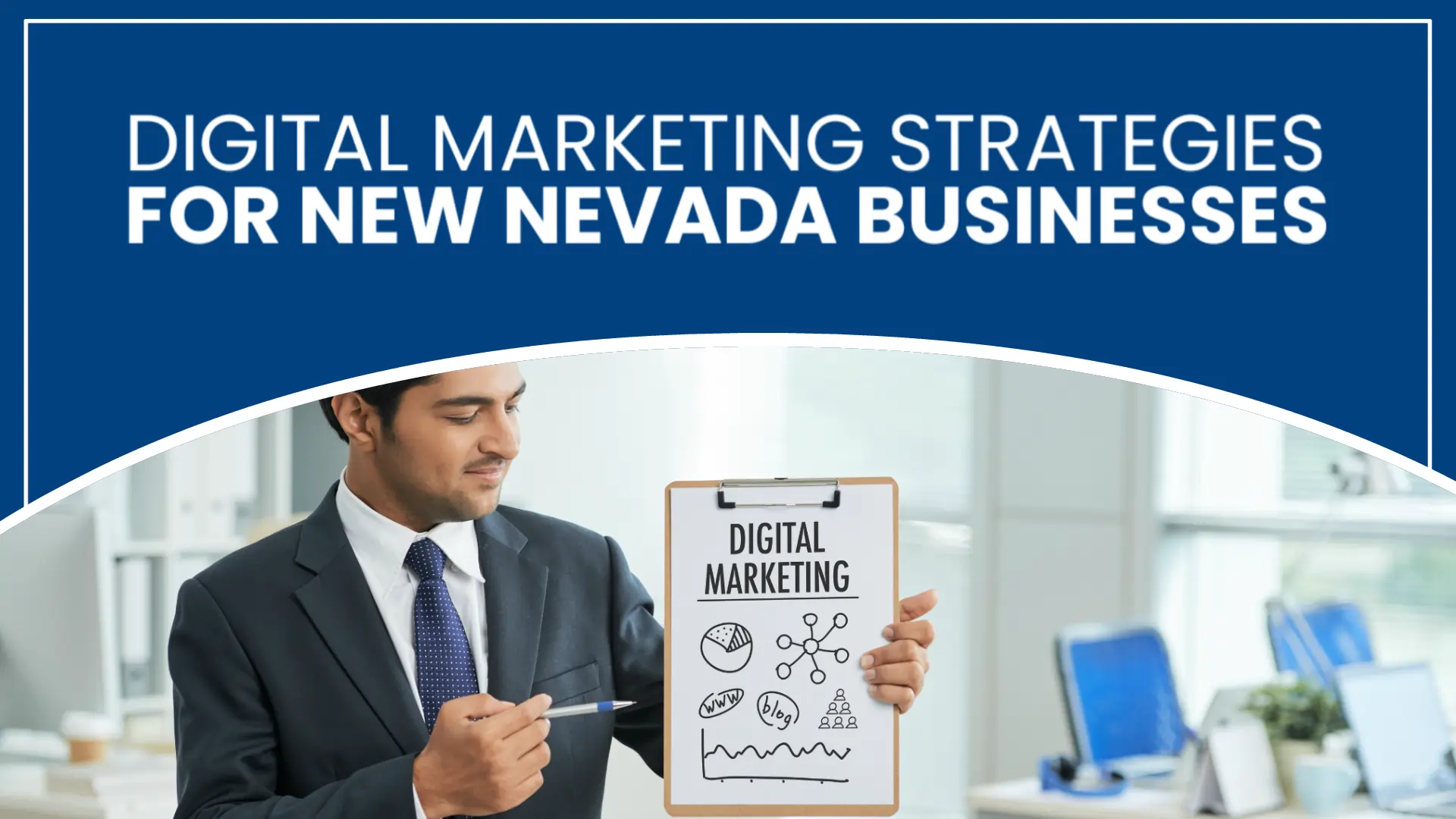1. Introduction
Nevada has gradually enhanced the environment for doing business and as such there is stiff competition among various players in industries. Establishing a new business in Nevada means that every consumer target needs to be reached through the digital platform not as an additional marketing tool but as an essential tool. The areas of focus of this paper include understanding which strategies are crucial for the new emerging businesses in Nevada to adopt in their multiphase digital marketing framework to achieve sustainability in the market. The following areas include the role of digital marketing in the local perspective, the need to have a business website, search engine optimization (SEO) and content marketing, social media marketing and pay-per-click (PPC), and marketing performance measurement using ROI.
2. Why Digital Marketing Matters for Nevada Businesses
Digital marketing is of immense importance in Nevada because the state has a diverse and evolving economy. Due to the rapid growth in commercialisation and globalisation, conventional modes like print media advertisements or verbal communication cannot effectively target the audience of tech-savvy and mobile-using consumers. Furthermore, the population is well educated especially in the use of technology in purchasing processes since most of them use Smartphones and social media platforms, search engines. This makes the participation of the consumers in digital marketing not only beneficial in results but also cost-effective.

Figure 1: Importance of Digital Marketing for Nevada Businesses (Source: Self-Created)
With the new trends that embrace remote working as well as online purchasing and consumption, clients expect entities and enterprises to also ensure that they are constantly online. Failure to adopt digital marketing solutions in an organisation exposes that business to risks such as struggling to gain much-needed credibility and missing out on other opportunities in the market. Thus, the proper approach to building a digital strategy will provide an answer to these challenges for new Nevada-based businesses and improve their performance in the digital environment.
3. Building an Effective Website
Any good digital marketing plan starts with the foundation of an optimal and appealing website for the business. For the new businesses in Nevada especially those that offer their products and services locally, the website therefore forms the first contact point of the brand with the customer. The table below provides the details regarding this.

Figure 2: Effective Website Process (Source: Self-Created)
Another aspect that needs to be implemented is the Accessibility Website. For meeting ADA Standards, every business should make their website accessible for disability because it is business benefit both for improving accessibility and avoiding the opposite risks. Lastly, the website should contain all the links to any form of digital marketing strategies whether it is through the use of e-mails, social media platforms, or online ads. Sign-up forms should be used to capture leads and provide valuable content to support the users throughout the buyer’s journey.

4. SEO and Content Marketing Basics
| Strategy Element | Application for Nevada Businesses | Benefits for New Nevada Startups |
| Keyword Research | Using tools like Google Keyword Planner to identify terms relevant to local Nevada audiences (e.g., “Vegas vegan cafés”) | Targeting local search intent increases discoverability among in-state customers |
| On-Page SEO | Optimising titles, meta descriptions, headers, and content on business websites for Nevada-specific keywords | Improving rankings in search results and enhancing user engagement |
| Off-Page SEO | Building backlinks from Nevada-based blogs, news sites, and directories | Increasing domain authority and credibility within regional markets |
| Local SEO | Creating and optimising Google Business Profiles, ensuring NAP consistency for Nevada locations | Enhancing visibility in Google Maps and local search results (important for Las Vegas & Reno markets) |
| Content Marketing | Publishing location-focused blogs, videos, or guides—e.g., “Top Family Activities in Henderson” | Building trust, brand awareness, and SEO ranking in localised markets |
| Customer Reviews | Encouraging satisfied local customers to leave reviews on Google and Yelp | Boosting social proof and improving local SEO signals |
| Multimedia Content | Creating videos or podcasts featuring Nevada-based topics or interviews with local influencers | Driving engagement and strengthening community connections |
| Analytics & Optimisation | Using tools like Google Analytics to monitor which Nevada-targeted content performs best | Informing future content strategy and enhancing return on investment |
Table 1: SEO and Content Marketing Strategies (Source: Self-Created)
5. Leveraging Social Media and Paid Ads
Social media marketing plays an essential role in communicating with the target audience. Nevada is one of the states where people are heavily involved in social networks. Businesses can make good use of it to increase their brand identity [Refer to table below].
| Platform/Channel | Best Used For | Benefits for Nevada Businesses |
| Local community engagement, event promotion | Helps build a strong local customer base and drive foot traffic | |
| Visual branding, influencer partnerships, product showcases | Increases brand visibility in tourist-heavy areas like Vegas | |
| Twitter/X | Real-time updates, local trends, customer interaction | Supports timely promotions tied to Nevada events or trends |
| B2B networking, recruitment, industry news | Connects with professionals in Nevada’s growing tech scene | |
| TikTok | Short-form viral content, engaging Gen Z audiences | Builds buzz and shares culture for newer, youth-focused brands |
| YouTube | Long-form video content, tutorials, product demos | Enhances trust with local consumers through detailed visuals |
| Google Ads (Search) | Capturing high-intent searches | Targets ready-to-buy customers searching for Nevada services |
| Google Display Ads | Brand awareness through visuals on websites/apps | Expands regional reach with eye-catching ads on local sites |
| Facebook/IG Ads | Highly targeted demographic/location-based ads | Drives store visits and website clicks from nearby residents |
| Influencer Marketing | Boosting credibility and reach | Builds social proof with audiences that trust local influencers |
Table 2: Social Media and Paid Advertising Strategies for Nevada Businesses (Source: Self-Created)
The advantage of paid advertising lies in the fact that it is highly quantifiable and can easily be expanded when necessary. Campaigns can be prepared for the launch, and it is possible to monitor and analyse the results and make changes to the creatives used in the advertisements, the target criteria or even the specified budget. Most importantly, these campaigns should lead people to a conversion page on the website such as a product offer page or registration form. Integrating organic and paid methods is important as it increases coverage and usage of products and services and must remain a critical element of the marketing plan of new businesses in Nevada.
6. Measuring Success and ROI of Your Marketing Efforts
The reason for this is that there is a need to measure the outcome of every business’s digital marketing strategy in order to determine the return on investment. The below table provides the details regarding the success measurement of digital marketing for Nevada businesses.
| Metric / KPI | Purpose | Calculation / Formula | Tool(s) to Use | Ideal Use Case / Insight |
| Sales Growth | Measures increase in revenue as a result of marketing efforts. | ((Current Period Sales – Previous Period Sales)/ Previous Period Sales) * 100 | Google Analytics, QuickBooks, CRM Software | Understand if marketing campaigns are driving revenue growth. |
| Customer Acquisition Cost (CAC) | Indicates how much it costs to acquire a new customer. | Total Marketing Spend / Number of New Customers Acquired | HubSpot, Salesforce, Zoho CRM | Evaluate the cost-effectiveness of campaigns and budget allocation. |
| Customer Lifetime Value (CLTV) | Estimates how much revenue a customer will bring during their lifetime. | Average Purchase Value × Purchase Frequency × Customer Lifespan | Excel, Shopify Analytics, CRM Tools | Helps justify CAC and forecast long-term profitability. |
| Conversion Rate | Measures the percentage of visitors who complete a desired action. | (Conversions / Total Visitors) * 100 | Google Analytics, Hotjar, Mailchimp | Assess landing page, ad, or email campaign effectiveness. |
| Cost Per Lead (CPL) | Tracks how much it costs to generate each lead. | Total Campaign Cost / Number of Leads Generated | Facebook Ads Manager, Google Ads, HubSpot | Optimise advertising spend; useful in comparing lead sources. |
| Return on Investment (ROI) | Evaluates the overall effectiveness of marketing spend. | ((Revenue from Campaign – Cost of Campaign) / Cost of Campaign) * 100 | Google Analytics, Excel, Business Intelligence Tools | Determine the profitability of campaigns. |
| Return on Ad Spend (ROAS) | Measures how much revenue is generated per dollar spent on ads. | Revenue from Ads / Cost of Ads | Google Ads, Meta Ads Manager | Assess the profitability of paid ad campaigns. |
| Unique Monthly Visitors | Tracks the number of distinct visitors per month. | Automatically recorded by analytics tools. | Google Analytics, SEMrush | Evaluate website reach and brand visibility. |
| Branded Search Lift | Measures increase in brand-related searches post-campaign. | (Post-Campaign Branded Searches – Pre-Campaign Branded Searches) / Pre-Campaign Branded Searches | Google Search Console, SEMrush | Understand the impact of branding campaigns and awareness. |
| Average Position | Indicates the average ranking of your website in search engine results. | Automatically provided by SEO tools. | Google Search Console, Ahrefs, SEMrush | Evaluate SEO performance and improve visibility. |
| Non-Brand CTR | Measures click-through rates for generic (non-branded) keywords. | (Non-Branded Clicks / Non-Branded Impressions) * 100 | Google Search Console, Google Ads | Optimise generic keyword strategies and assess content relevance. |
| Bounce Rate | Tracks the percentage of visitors who leave after viewing one page. | (Single Page Visits / Total Visits) * 100 | Google Analytics | Indicates engagement level and landing page effectiveness. |
| Email Open Rate | Tracks how many recipients open an email campaign. | (Emails Opened / Emails Sent) * 100 | Mailchimp, Constant Contact | Evaluate subject line and audience interest. |
| Social Engagement Rate | Measures interactions (likes, comments, shares) relative to followers or reach. | (Total Engagements / Total Followers or Reach) * 100 | Meta Insights, Hootsuite, Sprout Social | Assess content resonance on social media platforms. |
Table 3: Key Metrics for Measuring Digital Marketing Success and ROI (Source: Self-Created)
Example ROI Calculation
A major assumption made in the calculation of the quantitative ROI is that $7,000 is the total revenue generated by the specific digital marketing campaign without interference from any other factors. It also assumes the correct measure of customer conversion, the set time frame of the campaign, and constant rates. This is illustrated by the below example, which may in the real world be affected by multiple-touche point attribution, seasonality and other factors such as repeat business.
| Campaign Element | Value |
| Campaign Cost | $1,500 |
| Revenue Generated | $7,000 |
| ROI Formula | ((Revenue – Cost) / Cost) × 100 |
| ROI Calculation | ((7,000 – 1,500) / 1,500) × 100 |
| ROI Result | 366.67% |
| Interpretation | High ROI – the campaign was highly effective in generating revenue compared to its cost. |
Table 4: Example ROI Calculation (Source: Self-Created)
| Action | Purpose / Insight |
| 1. Identifying top-performing channels | Understanding which platforms deliver the best results per dollar spent. |
| 2. Monitoring trends over time | Spotting seasonal patterns or long-term shifts in customer behaviour. |
| 3. Setting benchmarks | Creating realistic performance goals based on historical data. |
| 4. Segmenting and personalising | Delivering more relevant content by refining target audiences. |
| 5. Testing different approaches | Improving ad performance through continuous experimentation. |
| 6. Optimising budget allocation | Investing more in high-performing campaigns while reducing spend elsewhere. |
Table 5: Using Data to Optimise Marketing in Nevada (Source: Self-Created)
7. Conclusion
Marketing range cannot be limited to physical billboards and local newspapers any longer. It has shifted into a more complex environment where the planning of the process, creativity, and the constant flow of the optimization is the key to success. For any new firms in Nevada, it becomes mandatory to pay attention to digital marketing as a way of survival and expansion. Beginning with creating a good website design including the process of search engine optimization and applying social media influence and that of paid ads, all channels are critical in building brand image and customer loyalty.
However, even the best campaigns go unnoticed if there is no constant evaluation and calculation of the return on investment. By looking strictly at Nevada, on factors such as rapid development, a high percentage of the populace with internet usage, and an enthusiastic business environment, the state presents itself to be ideal for experimenting with new ideas. It’s quite clear that through the use of versatile, analytical and customer-oriented approaches, the newest business or startups Nevada companies are capable of establishing themselves firmly within the specified market. Thereby create a firm foundation for further growth and development.



Leave a Reply